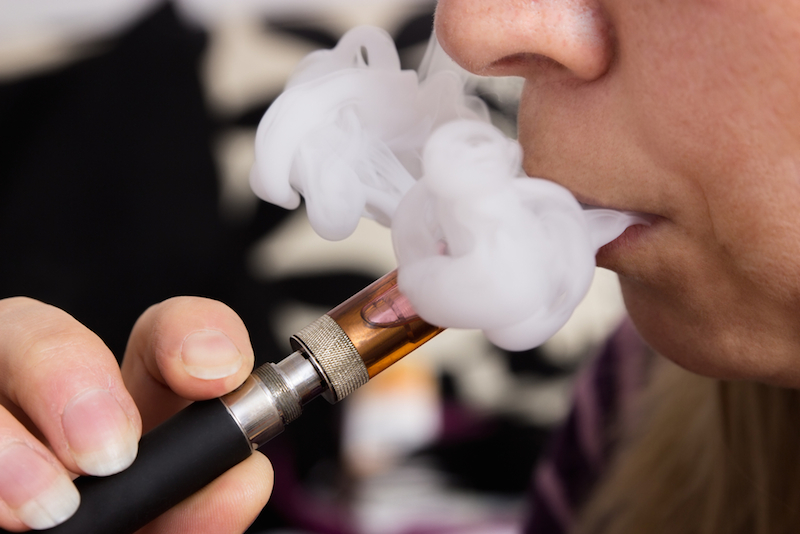Deadly Explosions Added to List of E-Cigarette Dangers

Electronic cigarettes can cause deadly explosions if the wrong type of charger is used, according to recent news reports. This is just one of the unforeseen risks associated with smoking e-cigs, which is also sometimes called vaping.
A 62-year-old Englishman died Friday (Aug. 8) after an incompatible charging device led an e-cigarette to blow up, and cause the explosion of a nearby oxygen tube from an oxygen concentrator, the BBC reported. In July, another case of a person using an incorrect charging device for an e-cigarette led to a fire that ignited an air-horn canister and caused an explosion that destroyed part of a house, the BBC found.
"It wouldn't surprise me to hear of more of these incidents happening," said Dr. Michael Steinberg, an internist at Rutgers University in New Jersey.
Some former cigarette smokers who turn to e-cigarettes have chronic lung diseases such as emphysema, and may rely on oxygen concentrators to help them breathe, Steinberg told Live Science. [Kick the Habit: 10 Scientific Quit-Smoking Tips]
E-cigarettes, which have gained popularity in the past 10 years, vaporize a solution that typically includes nicotine, the addictive part of tobacco. Models vary, but each has an inhaler that holds the e-liquid, and a battery that heats it into a vapor.
Both of the reported accidents in the United Kingdom happened when people used improper devices to power the e-cigarettes' rechargeable batteries — a problem that can happen with any electronic gadget, even a cellphone, but is exacerbated if an oxygen canister is nearby, Steinberg said.
People may use e-cigarettes because the devices do not require a user to inhale tobacco, nor do they produce secondhand smoke. But it's unclear whether the devices help people quit their nicotine addiction altogether, or if they simply cause people to switch from regular cigarettes to electronic ones.
Sign up for the Live Science daily newsletter now
Get the world’s most fascinating discoveries delivered straight to your inbox.
Moreover, e-liquids present health problems, Steinberg and other experts said. The main components of e-liquid are propylene glycol and vegetable glycerin, two compounds that the U.S. Food and Drug Administration (FDA) recognizes as safe food additives. However, the Centers for Disease Control and Prevention lists propylene glycol as a toxic substance, and Thomas Eissenberg, a professor of psychology and director of the Center for Tobacco Products at Virginia Commonwealth University, said researchers don't know what long-term effects these compounds may have on the lungs when they are inhaled.
Some e-liquids also include flavoring and nicotine, which may pose health problems when they are vaporized and inhaled, Eissenberg told Live Science. He and his colleagues are planning to do a six-month study that looks at the effects of e-cigarettes on people, but until more evidence is gathered, people serious about kicking their smoking habit should turn to e-cigarettes only if they plan to stop using them in three to six months, because the long-term effects on health are unknown, he said.
It's unlikely that e-cigarette users will get tobacco-caused diseases such as chronic obstructive pulmonary disease, or emphysema, "but there are e-cigarette diseases that they could die of that we simply don't know anything about now," Eissenberg said.
Poisonings from e-cigarettes and their e-liquids are also increasing. In September 2010, U.S. poison-control centers received just one call related to e-cigarettes, compared with 215 calls in February 2014, the Centers for Disease Control and Prevention reported in April.
Many of the calls involved children who ingested the nicotine, but poisonings also happened when people inhaled too much nicotine, or absorbed it through their skin. The stimulant often causes people to vomit and increases heart rate. Experts recommend that people handle e-liquids with gloves, in a well-ventilated area.
Many e-cigarettes deliver only a small amount of nicotine, which may have sparked a new dangerous trend called "dripping," said Dr. Michael Weaver, a professor of psychiatry and behavioral sciences at the University of Texas Health Science Center at Houston.
Dripping involves using an eyedropper to drip the e-liquid directly onto the heating coil or onto another hot surface, such as an electric stove, so that a user can inhale a higher dose of nicotine. E-liquids come in varying doses of nicotine, and the FDA does not regulate them, or e-cigarettes.
"One of the risks is, buyer beware," Weaver told Live Science. "You don't always know what you're getting, especially if you're ordering from an Internet site."
Follow Laura Geggel on Twitter @LauraGeggel and Google+. Follow Live Science @livescience, Facebook & Google+. Original article on Live Science.

Laura is the archaeology and Life's Little Mysteries editor at Live Science. She also reports on general science, including paleontology. Her work has appeared in The New York Times, Scholastic, Popular Science and Spectrum, a site on autism research. She has won multiple awards from the Society of Professional Journalists and the Washington Newspaper Publishers Association for her reporting at a weekly newspaper near Seattle. Laura holds a bachelor's degree in English literature and psychology from Washington University in St. Louis and a master's degree in science writing from NYU.









